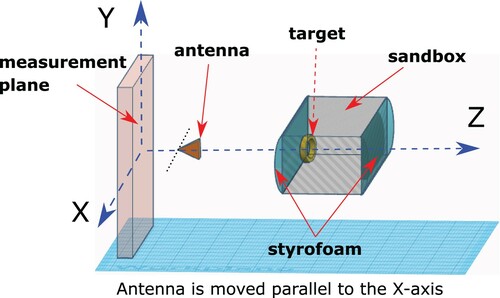Figures & data
Figure 1. A schematic diagram illustrating our experimental configuration. The transmitter is the antenna put in front of the detector placing the far-field measurement site. The backscattering waves hit the antenna before reaching the detectors. This causes a certain noise in the data.

Figure 2. Aluminium cylinder; see Tables – for further details. (a) and (b) A clear advantage of the data propagation procedure in data preprocessing. (a) Real part of raw and propagated data at . (b) Imaginary part of raw and propagated data at
. (c) Left: Aluminium cylinder (cf. [Citation2]). Middle: Image of computed dielectric constant. Right: Image of computed conductivity.
![Figure 2. Aluminium cylinder; see Tables 1–2 for further details. (a) and (b) A clear advantage of the data propagation procedure in data preprocessing. (a) Real part of raw and propagated data at α=0.4. (b) Imaginary part of raw and propagated data at α=0.4. (c) Left: Aluminium cylinder (cf. [Citation2]). Middle: Image of computed dielectric constant. Right: Image of computed conductivity.](/cms/asset/9fc38756-a244-43d5-b6f1-598922be02ad/gipe_a_1802447_f0003_oc.jpg)
Table 1. Chosen wavenumbers, frequencies and wavelength for Examples 1–5.
Table 2. True 
 , computed
, computed 
 dielectric constants and computed conductivity
dielectric constants and computed conductivity 
 of Examples 1–5 of experimental data. True values of dielectric constants were taken from: (a) Examples 1, 4, 5: formula (7.2) of [Citation40], (b) Example 2 (clear water) [Citation38], (c) Example 3 [Citation41].
of Examples 1–5 of experimental data. True values of dielectric constants were taken from: (a) Examples 1, 4, 5: formula (7.2) of [Citation40], (b) Example 2 (clear water) [Citation38], (c) Example 3 [Citation41].
Figure 3. A bottle of clear water; see Tables – for further details. Note that we can image even a tiny part of it: the cap of this bottle, at least when we compute the dielectric constant. (a) and (b) A serious data improvement due to the data propagation procedure. (a) Real part of raw and propagated data at . (b) Imaginary part of raw and propagated data at
. (c) Left: Glass bottle (cf. [Citation2]). Middle: Image of computed dielectric constant. Right: Image of computed conductivity.
![Figure 3. A bottle of clear water; see Tables 1–2 for further details. Note that we can image even a tiny part of it: the cap of this bottle, at least when we compute the dielectric constant. (a) and (b) A serious data improvement due to the data propagation procedure. (a) Real part of raw and propagated data at α=0.4. (b) Imaginary part of raw and propagated data at α=0.4. (c) Left: Glass bottle (cf. [Citation2]). Middle: Image of computed dielectric constant. Right: Image of computed conductivity.](/cms/asset/7f8b6eae-c0ff-48fb-a185-a4e8c6f80132/gipe_a_1802447_f0005_oc.jpg)
Figure 4. U-shaped piece of dry wood; see Tables – for further details. Note that we can image even the void of this nonconvex target. It is well known that imaging of nonconvex targets with voids in them is a quite challenging goal. This is especially true for the most challenging case we consider: backscattering nonoverdetermined data. (a) Real part of raw and propagated data at . (b) Imaginary part of raw and propagated data at
. (c) Left: U-shaped piece of dry wood (cf. [Citation2]). Middle: Image of computed dielectric constant. Right: Image of computed conductivity.
![Figure 4. U-shaped piece of dry wood; see Tables 1–2 for further details. Note that we can image even the void of this nonconvex target. It is well known that imaging of nonconvex targets with voids in them is a quite challenging goal. This is especially true for the most challenging case we consider: backscattering nonoverdetermined data. (a) Real part of raw and propagated data at α=0.5. (b) Imaginary part of raw and propagated data at α=0.5. (c) Left: U-shaped piece of dry wood (cf. [Citation2]). Middle: Image of computed dielectric constant. Right: Image of computed conductivity.](/cms/asset/d4a49aee-954f-48ac-b9c8-b2c21348be86/gipe_a_1802447_f0007_oc.jpg)
Figure 5. A-shaped metallic target. The same comments as ones for Figure are applicable here. (a) Real part of raw and propagated data at . (b) Imaginary part of raw and propagated data at
. (c) Left: Metallic letter ‘A’ (cf. [Citation2]). Middle: Image of computed dielectric constant. Right: Image of computed conductivity.
![Figure 5. A-shaped metallic target. The same comments as ones for Figure 4 are applicable here. (a) Real part of raw and propagated data at α=0.2. (b) Imaginary part of raw and propagated data at α=0.2. (c) Left: Metallic letter ‘A’ (cf. [Citation2]). Middle: Image of computed dielectric constant. Right: Image of computed conductivity.](/cms/asset/2c2e0cbe-4f0d-4663-8d8d-e56bdbdcbd9c/gipe_a_1802447_f0009_oc.jpg)
Figure 6. O-shaped metallic target. The same comments as ones for Figure are applicable here. (a) Real part of raw and propagated data at . (b) Imaginary part of raw and propagated data at
. (c) Left: Metallic letter ‘O’ (cf. [Citation2]). Middle: Image of computed dielectric constant. Right: Image of computed conductivity.
![Figure 6. O-shaped metallic target. The same comments as ones for Figure 4 are applicable here. (a) Real part of raw and propagated data at α=0.6. (b) Imaginary part of raw and propagated data at α=0.6. (c) Left: Metallic letter ‘O’ (cf. [Citation2]). Middle: Image of computed dielectric constant. Right: Image of computed conductivity.](/cms/asset/a7d98a87-2520-4d66-bb5d-00faa9a7b644/gipe_a_1802447_f0011_oc.jpg)
